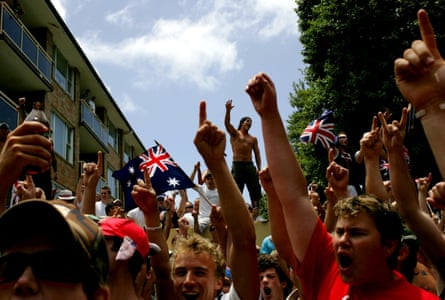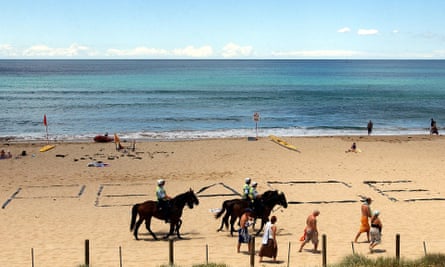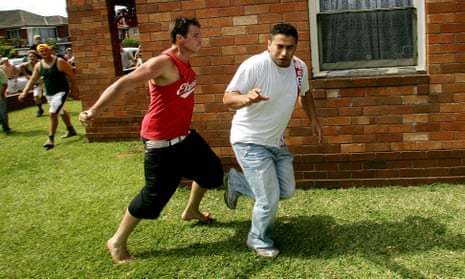Ten years ago Emma Cullen huddled behind a counter at the Cronulla McDonald’s with two men she had never met. They had dark skin and could have been Greek, Lebanese, Italian or from any number of Mediterranean countries. Outside, a waiting group of angry white men threw bottles and yelled insults, waiting for the doors to be unlocked.
“The police came and they had to back the paddywagon up to the doors,” she says. “They had to escort the two guys out. But people were throwing bottles when they were doing it, there was glass coming in under the doors, the poor guys.
“They got essentially treated like criminals, because they got put into the back of the paddywagon to get them out.”
It’s now 10 years since the Cronulla riots and Cullen – who grew up in the area and is still a volunteer lifesaver at Wanda beach – says she has never since seen anything quite like it. The sudden violence that shook the community some locals call “God’s country” came on faster than anyone could believe.
“Nobody would have picked how sour it turned that day,” she says. “It was disgusting. It was nearly like a war zone.”
Cronulla is filled with stories like Cullen’s. Many people can recall close encounters with violent troublemakers, windows smashed in during reprisal attacks and the sight of police running across the street in pursuit of offenders.
But while most residents did not take part in the riots, the community has been irrevocably linked to one of Australia’s more shameful displays of racism, one that made headlines around the world. Cronulla became a clarion call for racists around the country to unite.
But 10 years on, as Australia continues to grapple with race and religion, has Cronulla changed? And can the community move on from the stigma cast over it?

How the riots began: a long, hot summer
December in Cronulla is always a busy month. When summer finally arrives, South and North Cronulla beaches are the first to fill up. As Sydney’s only beach with direct train access, Cronulla has always been an attractive destination for Sydneysiders from the St George region and the city’s west seeking relief from the heat. Teenagers will sneak away from school for a dip on those scorching days when the air conditioners give out entirely.
December 2005 began the same way, but people who spent time at the beach had felt a change growing over a few months. Brawls – many racially motivated – had been steadily growing both in frequency and number.
In October 2005, two months before the riots, about 70 local youths and 40 men believed to be of Middle Eastern origin gathered, according to the police, “for what was believed to be a brawl”. Police managed to contain the clash without arrests but issued a number of move-on orders.
“It is feared this may become an ongoing problem in the Cronulla beach area,” then sergeant Grant Lister wrote in the police’s computer system after the events of October. “Many local beach users have the opinion that Cronulla beaches are for locals only and show an obvious racial prejudice against Middle Eastern males.”
Lister was right. Two months later tensions reached a critical point after reports of a fight between three off-duty lifesavers at North Cronulla beach and a group of eight men of Middle Eastern appearance.
The men were glaring at each other, sparking a rebuke from one of the Middle Eastern men. According to the police reports, one of the lifesavers told them: “I’m allowed to, now fuck off and leave our beach.”
The exchange continued and the lifesaver then reportedly said: “I come down here out of my own spare time to save you dumb cunts from drowning, now piss off, you scum.”
Both groups began pushing and shoving. Eventually punches were thrown. The first was attempted by one of the Middle Eastern men, although he missed the lifesaver he was aiming for. The lifesavers, outnumbered, sustained a number of injuries, while the Middle Eastern men left as the police arrived. One of them was later charged with assault.
Although the lifesavers’ behaviour was hardly admirable, the narrative that three volunteer lifesavers had been bashed was powerful. This encounter was the catalyst for an extraordinary display of unrest.
Text messages began circulating around the Sutherland shire – and also to the west and north of Sydney – with a blunt message. One read: “Just a reminder that Cronulla’s 1st wog bashing day is still on this Sunday. Chinks bashing day is on the 27th and the Jews are booked in for early January.”
The radio host Alan Jones took up the cause with great enthusiasm. He was outraged by the story of the lifesavers and the tales his listeners recounted of “lebs” and “wogs” at the beach. He told his 2GB listeners during the week that he was a proponent of “a rally, a street march, call it what you will. A community show of force.”

The result, Cullen says, was a period of chaos like no other in Cronulla. “I understood to an extent,” she says. “I personally was outraged about the story coming out about the lifesavers getting bashed. Because I’m a lifesaver too, and I find it outrageous that a volunteer would get bashed.
“I always thought it was something that would flop over. I didn’t actually think it would happen.”
On Sunday 11 December thousands gathered at North Cronulla beach. They wore Australian flags. They had tattooed southern cross flags on their faces and arms. And, perhaps most importantly, they were drinking.
Violence quickly began to spill out on to the streets off the beach. Anyone with darker skin was targeted. The police – and some brave residents – tried to stave off assaults against some of the men near the park at North Cronulla beach.
The rioters eventually made it to the mall, where Cullen and others were working. The streets had emptied out. Only police and rioters were in sight. The violence continued for hours until police contained it.
A week of violence erupts in Sydney streets
Police made dozens of arrests on charges ranging from assault to affray and breach of bail conditions. They men they arrested came from Cronulla, but also Jannali, Riverwood and other nearby suburbs.
After the initial violence, reprisal attacks began. A text message was distributed that said: “All arabs unite as one we will never back down to anyone the aussies will feel the full force of the arabs as one brothers in arms. Unite now lets show them who’s boss destroy everything gather at Cronulla 18/12/2005 midday; spread the message to all arabs meet up at the light house.”
Convoys of cars were seen moving across Sydney and into the Shire. They were described as men of Middle Eastern appearance but no one is certain of their ethnicity. Some smashed windows and cars, and the violence continued to sweep across the Shire.

More attacks – some by white men in response to the violence in Cronulla – occurred in Maroubra and Brighton-Le-Sands, where a group of more than 200 “began throwing missiles” at officers, according to a police release at the time.
After several days the reprisal attacks stopped. Cronulla, and Australia, was left to make sense of what had happened.
The vexed response: law and order, and community engagement
The initial response from political leaders inevitably targeted the efficacy of law enforcement. The then prime minister, John Howard, said “mob violence is always sickening” – but he denied it was racially linked.
As a result of the disorder, NSW police were granted unprecedented powers to search and detain people in the state. Perhaps the most controversial power they were granted was the ability to “lock down” areas.
The commissioner of police was granted the power to essentially shut down entire streets, or even neighbourhoods, in the event of unrest. The powers allow police to confiscate property and search on sight when they believe a person may be involved in a disturbance.
A new offence of assault during a period of disturbance was created, and the maximum sentence for rioting was increased to 10 years.
A review was also established – known as Strike Force Neil – to analyse how the police behaved and assess the leadup to the riots.
A range of community programs was set up to, including the “On the Same Wave” initiative to get young Muslims involved in surf lifesaving. But the program has been less successful than some hoped. Guardian Australia understands that none of the participants are still involved in surf lifesaving.
Cronulla’s stigma prevents Australia moving forward
One lingering outcome of the riots has been the persistent public perception of Cronulla as a racist place.
The stigma has undoubtedly affected the region. In the immediate aftermath of the unrest, few Australians from ethnically diverse backgrounds continued to visit its beaches. Many have not returned at all.
Natascha Klocker, from the Australian Centre for Cultural Environment Research, has argued that the stigma damages both Cronulla and Australia.
“There are two big problems with this stigmatising,” she says. “One is that when Cronulla is portrayed as a problem area it becomes more difficult to reflect more broadly on the problem of racism in Sydney and in Australia.

“The second big problem is that when Cronulla and the Sutherland shire are portrayed as racist, that stereotype becomes a barrier. And it makes harder for people from different ethnic and religious groups to spend time in Cronulla.
“There are other things that happen in this place. Good and bad, but there are other things, and perhaps it’s time to move on and report on some other things.”
Ten years on, will a ‘memorial’ rally stoke tensions again?
The anniversary of the riots has gained particular attention from far-right groups. The Party for Freedom, led by Nick Folkes, has planned a 10-year “memorial rally” on Saturday to mark the riot’s anniversary.
The planned rally is, in some ways, a test for Cronulla. At this stage, the prospects that it will go ahead are dim. The mayor of the Sutherland shire council, Carmelo Pesce, says the council has taken a range of steps to prevent it from happening.
NSW police have sought an injunction in the supreme court, and the council has done the same in the federal court, along with the community advocate Jamal Rifi. Both matters are due in court on Wednesday.
Pesce says Folkes’s group does not appear to have much local support after it made plans to distribute flyers at Cronulla mall.
“Nick Folkes and his folks were looking to come down on Monday,” he says. “They said they would have about 100 people helping. About two people showed up.
“If it does go ahead it will be contained.”
For Cullen, and other residents, the rally is of little interest. For them, Cronulla is a very different place to what it was 10 years ago.
“I don’t reckon anyone from Cronulla would show up,” she says. “Nobody is interested in it.”
- Comments on this thread will be open later today

Comments (…)
Sign in or create your Guardian account to join the discussion